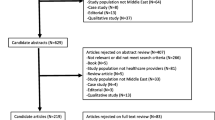Abstract
Conditions believed to produce burnout are examined empirically with the Gillespie-Numerof Burnout Inventory (GNBI) in a sample of 154 health service professionals. The GNBI was administered in a 205-bed, religious-affiliated general hospital located in a major midwestern city. Findings indicate that burnout is inversely related to two job characteristics: degree of formalization and perceived adequacy of communication with supervisor; and burnout is related inversely to three provider characteristics: age, marital status, and years of experience in present position. Age of the provider and communication with supervisor are strongly related to burnout.
Similar content being viewed by others
References
Blalock, H.M. (1972).Social statistics (2nd ed.). New York: McGraw-Hill.
Bramhall, M., & Ezell, S. (1981) How burned out are you?Public Welfare, 39, 23–27.
Bramhall, M., & Ezell, S. (1981). Working your way out of burnout.Public Welfare, 39, 32–39.
Carroll, J.F.X. (1979). Staff burnout as a form of ecological dysfunction.Contemporary Drug Problems, 8, 207–225.
Charns, M., & Beattie, H. (1982, August). Organizational correlates of housestaff burnout. Paper presented at the Academy of Management, New York,
Charns, M., Stoelwinder, J., Millen, R., & Schaefer, M. (1981, August). Coordination and patient-unit effectiveness: A study of organizational factors affecting patient care. Paper presented at the Academy of Management, New York.
Cherniss, C. (1980).Professional burnout in human service organizations. New York: Praeger Press.
Daley, M.R. (1979). Burnout: Smouldering problem in protective services.Social Work, 45, 375–450.
Daley, M.R. (1979). Preventing worker burnout in child welfare.Child Welfare, 58, 443–450.
Farber, B.A. (1981). Current trends, future perspectives. In C.A. Farber (Ed.),Stress and burnout in the human service professions. New York: Pergamon Press.
Farber, B.A., & Heifetz, L.J. (1982). The process and dimensions of burnout in psychotherapists.Professional Psychology, 13, 293–301.
Freudenberger, H.J. (1977). Burnout: The organizational menace.Training and Development Journal, 31, 26–27.
Georgopoulos, B.A., & Mann, F.B. (1962).The community general hospital. New York: Macmillan.
Gillespie, D.F. (1981). Correlates of active and passive types of burnout.Journal of Social Service Research, 4, 1–16.
Gillespie, D.F. (1983): Understanding and combatting burnout.Public administration bibliography. Monticello, IL: Vance Bibliographies.
Gillespie, D.F., & Cohen, S.E. (1984). Causes of worker burnout.Children and Youth Services Review, 6, 115–124.
Gillespie, D.F., & Numerof, R.E. (1984a). The development of a unidimensional measure of burnout: The GNBI (Working paper) St. Louis, MO: Washington Univ.
Gillespie, D.F., & Numerof, R.E. (1984b).The Gillespie-Numerof burnout inventory: Technical manual (1st ed.). St. Louis, MO: Washington Univ.
Hage, J., & Aiken, M. (1969). Routine technology, social structure, and goals.Administrative Science Quarterly, 14, 366–376.
Kahn, R. (1978). Job burnout: Prevention and remedies.Public Welfare, 36.
Levinson, H. (1981). When executives burn out.Harvard Business Review, 59, 72–81.
Maslach, C. (1978). Client role in staff burnout.Journal of Social Issues, 34, 111–124.
Maslach, C. (1978). Job burnout: How people cope.Public Welfare, 36, 56–58.
Maslach, C., & Jackson, S.E. (1981). The measurement of experienced burnout.Journal of Occupational Behavior, 2, 99–113.
Minahan, A. (1980). Burnout and educational change.Social Work, 25, 87.
Numerof, R.E., & Abrams, M.H. (1983, August).Sources of stress among nurses: An empirical investigation. Paper presented at the 43rd Annual Meeting of the Academy of Management, Dallas, TX.
Pines, A., & Maslach, C. (1978). Characteristics of staff burnout in mental health settings.Hospital and Community Psychiatry, 29, 233–237.
Pines, A., & Maslach, C. (1980). Combatting staff burnout in a day care center: A case study.Child Care Quarterly, 1, 5–16.
Scriven, R., Moe, D., & Sparks, D. (1979). Special feature on burnout: The blick click and a prescription.Today's Education, 68(4), 34–37.
Seiderman, S. (1978). Combatting staff burnout.Day Care and Early Education, Summer, 1–10.
Shubin, S. (1978). Burnout: The professional hazard you face in nursing.Nursing, 78, 22–78.
Smith, P.C., Kendall, L.M., & Hulin, C.H. (1969).The measurement of satisfaction in work and retirement. Chicago: Rand-McNally.
Snider, J.G., & Osgood, C.E. (Eds.). (1969).Semantic differential technique. Chicago: Aldine.
Streepy, J. (1981). Direct service providers and burnout.Social Casework, 62, 352–361.
Thompson, J.W. (1980). Burnout in group home house-parents.American Journal of Psychiatry, 137, 710–714.
Weiskopf, P.E. (1980). Burnout among teachers of exceptional children.Exceptional Children, 47, 18–23.
Whitebook, M. (1981). Who's minding the child care workers? A look at staff burnout.Children Today, 10, 2–6.
Author information
Authors and Affiliations
Rights and permissions
About this article
Cite this article
Gillespie, D.F., Numerof, R.E. Burnout among health service providers. Adm Policy Ment Health 18, 161–171 (1991). https://doi.org/10.1007/BF00713800
Issue Date:
DOI: https://doi.org/10.1007/BF00713800




